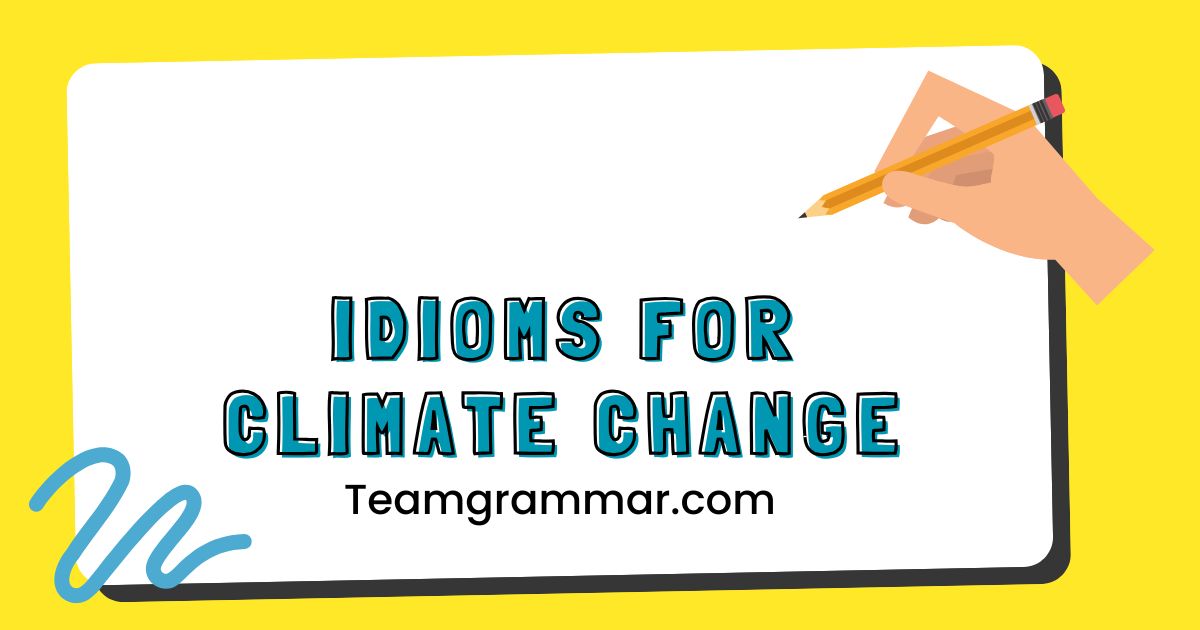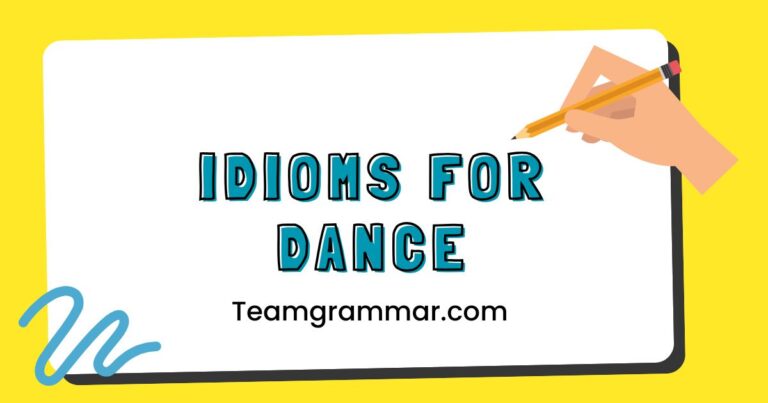43 Idioms for Climate Change: A Comprehensive Guide
Understanding climate change is crucial in today’s world, and effectively communicating about it is equally important. Idioms, while colorful and expressive, can sometimes obscure the precise meanings needed in scientific or policy discussions.
This article explores common idioms used in the context of climate change, providing clear definitions, examples, and usage guidelines. It aims to help learners, educators, and professionals navigate the nuances of discussing this critical global issue, ensuring clarity and accuracy in their communication.
This guide is designed for English language learners, environmental science students, journalists, policymakers, and anyone interested in improving their understanding and communication skills related to climate change. By mastering these idioms, readers can enhance their comprehension of climate-related discussions and express themselves more effectively.
Table of Contents
- Introduction
- Definition of Idioms
- Structural Breakdown of Idioms
- Types and Categories of Climate Change Idioms
- Examples of Climate Change Idioms
- Usage Rules for Climate Change Idioms
- Common Mistakes When Using Climate Change Idioms
- Practice Exercises
- Advanced Topics in Climate Change Idioms
- Frequently Asked Questions
- Conclusion
Definition of Idioms
An idiom is a phrase or expression whose meaning cannot be understood from the ordinary meanings of the individual words. It’s a figure of speech that relies on a cultural understanding and shared linguistic knowledge.
Idioms are often colorful and vivid, adding richness to language, but they can also be confusing for non-native speakers or those unfamiliar with the specific cultural context.
In the context of climate change, idioms can be used to simplify complex environmental issues, making them more relatable or emotionally resonant. However, it’s essential to use them judiciously to avoid ambiguity or misinterpretation, especially in formal or scientific communication.
Classification of Idioms
Idioms can be classified based on their structure and function. Some common classifications include:
- Phrasal Verbs: These consist of a verb and a particle (e.g., die out, wipe out).
- Clichés: Overused idioms that have lost their impact (e.g., tip of the iceberg).
- Proverbs: Short, well-known sayings that express a general truth (e.g., a stitch in time saves nine – applicable to preventative climate action).
- Metaphorical Idioms: These use figurative language to convey a meaning (e.g., a perfect storm).
Function of Idioms
Idioms serve several functions in communication:
- Emphasis: They can add emphasis or emotional weight to a statement.
- Simplification: They can simplify complex ideas into more easily digestible forms.
- Cultural Connection: They create a sense of shared understanding within a cultural group.
- Engagement: They can make language more engaging and memorable.
Contexts for Using Climate Change Idioms
Climate change idioms can be found in various contexts, including:
- News Articles: Used to make climate change stories more accessible to the general public.
- Policy Debates: Employed to frame arguments and persuade audiences.
- Educational Materials: Utilized to explain complex concepts in a relatable way.
- Everyday Conversations: Used to discuss climate change concerns and solutions.
Structural Breakdown of Idioms
Understanding the structure of idioms involves recognizing that their overall meaning is different from the sum of their individual parts. Idioms often defy the standard rules of grammar and syntax, which is why they can be challenging for language learners.
The structure of idioms can be analyzed at several levels:
- Lexical Level: Examining the individual words and their literal meanings.
- Syntactic Level: Analyzing the grammatical structure of the phrase.
- Semantic Level: Understanding the overall meaning of the idiom in context.
For example, consider the idiom “nip it in the bud,” which means to stop something at an early stage before it develops into something worse. Lexically, “nip,” “bud,” and “in” have their individual meanings.
Syntactically, the phrase follows a basic verb-object-preposition structure. However, semantically, the idiom refers to preventing a problem from escalating, drawing a parallel to stopping a flower from blooming.
Types and Categories of Climate Change Idioms
Climate change idioms can be categorized based on the specific aspect of climate change they relate to, or the way they convey meaning.
Idioms Related to Environmental Impact
These idioms describe the consequences of climate change on the environment.
Idioms Related to Action or Inaction
These idioms refer to efforts to address climate change or the lack thereof.
Idioms Related to Severity and Urgency
These idioms emphasize the seriousness and time-sensitivity of climate change.
Examples of Climate Change Idioms
The following tables provide examples of climate change idioms, categorized by their meaning and usage. Each table includes a definition of the idiom and example sentences to illustrate its use.
Examples Related to Environmental Impact
This section provides examples of idioms that describe the consequences of climate change on the environment. These idioms often use vivid imagery to convey the severity and scope of the environmental damage.
| Idiom | Definition | Example Sentence |
|---|---|---|
| Tip of the iceberg | A small, visible part of a much larger, hidden problem. | The melting glaciers are just the tip of the iceberg when it comes to the effects of climate change. |
| Turning the tide | Reversing a negative trend or situation. | Investing in renewable energy is crucial for turning the tide against climate change. |
| Between a rock and a hard place | Faced with two difficult choices. | Developing nations are between a rock and a hard place, needing economic growth but also needing to reduce emissions. |
| The canary in the coal mine | An early warning sign of a greater danger. | The dying coral reefs are the canary in the coal mine, warning us about the devastating effects of climate change. |
| A drop in the bucket | A very small amount compared to what is needed. | Individual efforts to reduce carbon footprint are just a drop in the bucket without systemic change. |
| When it rains, it pours | When bad things happen, they tend to happen all at once. | With rising sea levels and extreme weather events, it seems that when it rains, it pours for coastal communities. |
| A slippery slope | An action that seems harmless at first but could lead to negative consequences. | Ignoring climate change is a slippery slope that could lead to irreversible environmental damage. |
| The writing is on the wall | Clear signs that something bad is going to happen. | The writing is on the wall regarding the future of our planet if we don’t take drastic action on climate change. |
| Go down the drain | To be wasted or lost. | Without proper conservation efforts, our natural resources will go down the drain. |
| Out of the woods | Out of danger or difficulty. | We won’t be out of the woods with climate change until we achieve net-zero emissions. |
| Walking on thin ice | In a risky or precarious situation. | Governments are walking on thin ice if they continue to delay climate action. |
| A vicious cycle | A series of events that reinforce each other negatively. | Deforestation and climate change create a vicious cycle, with each exacerbating the other. |
| Skating on thin ice | Behaving in a risky way. | Companies are skating on thin ice when they greenwash their environmental practices. |
| Open a Pandora’s Box | Unleash a series of unforeseen and negative consequences. | Geoengineering solutions could open a Pandora’s Box of unintended environmental effects. |
| The eleventh hour | The last possible moment. | We’re at the eleventh hour to take meaningful action on climate change. |
| Cooked goose | Ruined; doomed. | If we fail to reduce greenhouse gas emissions, the planet is a cooked goose. |
| A sea change | A significant and fundamental shift. | Adopting renewable energy sources represents a sea change in our approach to energy production. |
| Stem the tide | To stop something from increasing or continuing. | We need to stem the tide of plastic pollution in our oceans. |
| Close the barn door after the horse has bolted | To take preventive measures too late. | Trying to restore ecosystems after they’ve been destroyed is like closing the barn door after the horse has bolted. |
| A house of cards | A structure or plan that is weak and could easily collapse. | An economy built on fossil fuels is like a house of cards, vulnerable to climate change impacts. |
Examples Related to Action or Inaction
This section provides examples of idioms that refer to efforts to address climate change or the lack thereof. These idioms often highlight the importance of taking decisive action to mitigate and adapt to climate change.
| Idiom | Definition | Example Sentence |
|---|---|---|
| Put out fires | Deal with immediate problems instead of preventing them. | Instead of putting out fires, we need to address the root causes of climate change. |
| Miss the boat | To miss an opportunity. | If we don’t invest in green technology now, we’ll miss the boat on a sustainable future. |
| Drag one’s feet | To delay or be slow in doing something. | The government is dragging its feet on implementing climate policies. |
| Bury one’s head in the sand | To ignore a problem or danger. | We can’t afford to bury our heads in the sand when it comes to climate change. |
| Get the ball rolling | To start something. | Investing in renewable energy can get the ball rolling on a green economy. |
| A stitch in time saves nine | Addressing a problem early can prevent it from becoming worse. | Investing in preventative measures is like a stitch in time saves nine when it comes to climate change adaptation. |
| Pay the piper | Face the consequences of one’s actions. | Future generations will pay the piper for our inaction on climate change. |
| Turn over a new leaf | To make a fresh start. | It’s time for industries to turn over a new leaf and adopt sustainable practices. |
| Rome wasn’t built in a day | Important projects take time and effort. | Transitioning to a green economy won’t happen overnight; Rome wasn’t built in a day. |
| Cross that bridge when we come to it | Deal with a problem when it arises. | While some advocate for geoengineering, others prefer to cross that bridge when we come to it, focusing on mitigation first. |
| Back to square one | Having to start over from the beginning. | If the climate talks fail, we’ll be back to square one in the fight against global warming. |
| Make hay while the sun shines | Take advantage of a favorable situation. | We need to make hay while the sun shines and invest in renewable energy while it’s still economically viable. |
| Jump on the bandwagon | Join a popular trend or movement. | Many companies are jumping on the bandwagon of sustainability to improve their public image. |
| Step up to the plate | Take action and assume responsibility. | It’s time for world leaders to step up to the plate and commit to meaningful climate action. |
| Get one’s hands dirty | Become involved in practical work. | We need more people to get their hands dirty and participate in environmental restoration projects. |
| Put one’s money where one’s mouth is | Support one’s claims with concrete action. | Governments need to put their money where their mouth is and invest in green infrastructure. |
| Take the bull by the horns | Confront a difficult situation with courage and determination. | We need to take the bull by the horns and implement bold climate policies. |
| Clear the air | Resolve a misunderstanding or conflict. | Climate scientists need to clear the air about the realities of climate change. |
| Rock the boat | Disrupt the status quo. | Sometimes, we need to rock the boat to bring about meaningful change in climate policy. |
| Go against the grain | Act in opposition to prevailing norms or trends. | Investing in renewable energy is going against the grain in some fossil fuel-dependent regions. |
Examples Related to Severity and Urgency
This section provides examples of idioms that emphasize the seriousness and time-sensitivity of climate change. These idioms often convey a sense of impending crisis and the need for immediate action.
| Idiom | Definition | Example Sentence |
|---|---|---|
| A perfect storm | A combination of events that create a particularly bad situation. | Climate change, combined with deforestation and pollution, is creating a perfect storm for environmental disaster. |
| Playing with fire | Taking a dangerous risk. | Continuing to burn fossil fuels is like playing with fire, risking catastrophic climate change. |
| Up to one’s neck | Deeply involved in a difficult situation. | Coastal communities are already up to their necks in dealing with the impacts of rising sea levels. |
| Walking a tightrope | In a precarious or risky situation. | Developing countries are walking a tightrope, balancing economic growth with environmental sustainability. |
| On the brink | On the verge of something happening. | Many ecosystems are on the brink of collapse due to climate change. |
| A ticking time bomb | A situation that is likely to become dangerous or disastrous in the future. | The melting permafrost is a ticking time bomb, releasing large amounts of methane into the atmosphere. |
| Pushing one’s luck | Taking risks to an excessive degree. | We’re pushing our luck by continuing to delay action on climate change. |
| A point of no return | A threshold beyond which it is impossible to go back. | We’re approaching a point of no return in terms of irreversible climate change impacts. |
| A recipe for disaster | A situation that is likely to lead to very bad results. | Ignoring climate change and continuing with unsustainable practices is a recipe for disaster. |
| At stake | At risk. | The future of our planet is at stake if we don’t take action on climate change. |
| Hang in the balance | In an uncertain state. | The survival of many species hangs in the balance due to climate change. |
| A race against time | A situation in which there is very little time to achieve something. | Combating climate change is a race against time to reduce greenhouse gas emissions. |
| On a knife edge | In a tense or uncertain situation. | The outcome of international climate negotiations is often on a knife edge. |
| A shot across the bow | A warning sign. | Extreme weather events are a shot across the bow, warning us about the dangers of climate change. |
| A wake-up call | An event that makes one realize the need to take action. | The recent heatwaves have been a wake-up call for many people about the reality of climate change. |
| The last straw | The final problem in a series of problems that makes a situation unbearable. | For many farmers, the drought was the last straw, forcing them to abandon their livelihoods. |
| Skating on thin ice | Behaving in a risky way. | Governments are skating on thin ice by delaying climate action. |
| Touch and go | Uncertain and risky. | The recovery of some endangered species is touch and go due to climate change. |
| A sword of Damocles | A constant and imminent threat. | Climate change is like a sword of Damocles hanging over future generations. |
| Staring down the barrel of a gun | Facing a very dangerous situation. | We are staring down the barrel of a gun if we don’t reduce our carbon emissions. |
Usage Rules for Climate Change Idioms
Using idioms correctly requires understanding their specific meanings and the contexts in which they are appropriate. Here are some general rules to follow:
- Know the Meaning: Always ensure you fully understand the idiom’s meaning before using it.
- Consider the Audience: Be mindful of your audience’s familiarity with idioms. Avoid using them in formal or technical contexts where clarity is paramount.
- Maintain Consistency: Use idioms consistently throughout your writing or speech. Avoid mixing idioms or creating hybrid expressions.
- Avoid Overuse: While idioms can add color to your language, overusing them can make your writing sound cliché or unnatural.
- Check for Cultural Appropriateness: Be aware that some idioms may not translate well across cultures or may have different connotations in different regions.
Exceptions and Special Cases
There are always exceptions to general rules. Some idioms may be more widely understood than others, and some may be appropriate in certain formal contexts.
For example, “tip of the iceberg” is a relatively common idiom that might be acceptable in a broader range of situations than “the eleventh hour.”
Additionally, idioms can sometimes be modified or adapted for specific purposes, but this should be done with caution to avoid losing their original meaning or creating confusion.
Common Mistakes When Using Climate Change Idioms
Using idioms incorrectly can lead to misunderstandings and miscommunications. Here are some common mistakes to avoid:
- Misinterpreting the Meaning: Assuming an idiom means something different from its actual definition.
- Using the Wrong Idiom: Choosing an idiom that doesn’t quite fit the context or intended meaning.
- Mixing Idioms: Combining parts of different idioms, resulting in a nonsensical phrase.
- Taking Idioms Literally: Interpreting an idiom’s words at face value, rather than understanding its figurative meaning.
- Overusing Idioms: Cluttering your language with too many idioms, making it sound unnatural or forced.
Here are some examples of correct and incorrect usage:
| Incorrect | Correct | Explanation |
|---|---|---|
| “We are up to our heads in climate change problems.” | “We are up to our necks in climate change problems.” | “Up to our necks” is the correct idiom to describe being deeply involved in a difficult situation. |
| “The climate change boat has sailed.” | “We’ve missed the boat on climate change.” | “Missed the boat” is the correct idiom to describe missing an opportunity. |
| “We need to bury our heads in the sand and ignore climate change.” | “We can’t afford to bury our heads in the sand when it comes to climate change.” | The incorrect sentence uses the idiom in the opposite way of its intended meaning. |
Practice Exercises
Test your understanding of climate change idioms with these exercises.
Exercise 1: Fill in the Blanks
Choose the correct idiom from the list to complete each sentence.
Idiom List: tip of the iceberg, turning the tide, between a rock and a hard place, canary in the coal mine, a drop in the bucket
| Question | Answer |
|---|---|
| 1. The recent floods are just the ___________ of the climate change crisis. | tip of the iceberg |
| 2. Investing in renewable energy is essential for ___________ against climate change. | turning the tide |
| 3. Many developing nations are ___________, needing economic growth but also needing to reduce emissions. | between a rock and a hard place |
| 4. The declining bee population is the ___________, warning us about the dangers of environmental degradation. | canary in the coal mine |
| 5. Individual efforts to reduce waste are just ___________ without systemic change. | a drop in the bucket |
| 6. The melting arctic is the ___________ of the climate crisis. | tip of the iceberg |
| 7. To prevent the impact of climate change, it is important to start ___________ now. | turning the tide |
| 8. With growing populations and limited resources, many countries find themselves ___________, struggling to balance sustainability and progress. | between a rock and a hard place |
| 9. The extinction of a species is the ___________ of a greater environmental issue. | canary in the coal mine |
| 10. Although helpful, individual recycling efforts are ___________ compared to the scale of the pollution crisis. | a drop in the bucket |
Exercise 2: Matching
Match the idiom with its correct definition.
| Idiom | Definition | Answer |
|---|---|---|
| 1. Put out fires | a) Ignore a problem or danger | 1 – d |
| 2. Miss the boat | b) Delay or be slow in doing something | 2 – e |
| 3. Drag one’s feet | c) Face the consequences of one’s actions | 3 – b |
| 4. Bury one’s head in the sand | d) Deal with immediate problems instead of preventing them | 4 – a |
| 5. Pay the piper | e) To miss an opportunity | 5 – c |
| 6. Step up to the plate | f) Disrupt the status quo | 6 – h |
| 7. Get one’s hands dirty | g) Resolve a misunderstanding or conflict | 7 – i |
| 8. Rock the boat | h) Take action and assume responsibility | 8 – f |
| 9. Clear the air | i) Become involved in practical work | 9 – g |
| 10. Go against the grain | j) Act in opposition to prevailing norms or trends | 10 – j |
Exercise 3: Sentence Completion
Complete the following sentences using the appropriate idioms related to climate change severity and urgency.
Idiom List: Playing with fire, A perfect storm, Up to one’s neck, A point of no return, A ticking time bomb
| Question | Answer |
|---|---|
| 1. Continuing to ignore scientific warnings about climate change is like _____________. | Playing with fire |
| 2. The combination of rising sea levels, extreme weather events, and food shortages is creating _____________. | A perfect storm |
| 3. Coastal communities are already _______________ in dealing with the impacts of climate change. | Up to one’s neck |
| 4. If we don’t take drastic action soon, we may reach _______________ in terms of irreversible climate damage. | A point of no return |
| 5. The melting permafrost, releasing methane into the atmosphere, is _______________. | A ticking time bomb |
| 6. The combination of pollution, deforestation, and climate change created _______________. | A perfect storm |
| 7. Ignoring carbon emissions is _______________. | Playing with fire |
| 8. The local governments are _______________ in flood-relief efforts. | Up to one’s neck |
| 9. The rate of deforestation may soon hit _______________. | A point of no return |
| 10. Rising temperatures are _______________ for the climate. | A ticking time bomb |
Advanced Topics in Climate Change Idioms
For advanced learners, exploring the nuances and subtleties of climate change idioms can provide a deeper understanding of their usage and impact.
Idiomatic Variations
Idioms can sometimes be altered or adapted to suit specific contexts. However, it’s essential to do this carefully to avoid losing the original meaning or creating confusion.
For example, instead of saying “tip of the iceberg,” you might say “just the tip of the iceberg” to emphasize the smallness of the visible problem.
Cultural Context and Idioms
The meaning and relevance of idioms can vary across cultures. Some idioms may not translate well or may have different connotations in different regions.
Understanding the cultural context is crucial for using idioms effectively and avoiding misunderstandings.
Using Idioms for Persuasion
Idioms can be powerful tools for persuasion, as they can evoke emotions and create a sense of shared understanding. However, it’s essential to use them ethically and responsibly, avoiding manipulation or distortion of the facts.
Frequently Asked Questions
- What is an idiom?
An idiom is a phrase or expression whose meaning cannot be understood from the ordinary meanings of the individual words. It’s a figure of speech that relies on cultural understanding and shared linguistic knowledge.
- Why are idioms important in the context of climate change?
Idioms can simplify complex environmental issues, making them more relatable or emotionally resonant. However, they should be used judiciously to avoid ambiguity or misinterpretation.
- How can I avoid misusing climate change idioms?
Always ensure you fully understand the idiom’s meaning before using it, consider your audience, and avoid overusing idioms in formal or technical contexts.
- Are climate change idioms universal?
No, the meaning and relevance of idioms can vary across cultures. Some idioms may not translate well or may have different connotations in different regions.
- Can I modify or adapt climate change idioms?
Idioms can sometimes be altered or adapted for specific purposes, but this should be done with caution to avoid losing their original meaning or creating confusion.
- What are some common mistakes when using climate change idioms?
Common mistakes include misinterpreting the meaning, using the wrong idiom, mixing idioms, taking idioms literally, and overusing idioms.
- How can idioms be used for persuasion in climate change discussions?
Idioms can evoke emotions and create a sense of shared understanding, making them powerful tools for persuasion. However, they should be used ethically and responsibly.
- What is the difference between a cliché and an idiom?
A cliché is an overused idiom that has lost its impact, while an idiom is a phrase or expression whose meaning cannot be understood from the ordinary meanings of the individual words.
- How do I learn more climate change idioms?
Read news articles, listen to podcasts, and watch documentaries about climate change. Pay attention to the language used and note any idioms you encounter. Practice using them in your own writing and speech.
- Can I create my own climate change idioms?
While it’s possible to create new idioms, it’s challenging to get them widely adopted. It’s generally best to stick to established idioms that are already understood by your audience.
- What role do idioms play in climate change communication?
Idioms can help make complex climate change issues more accessible and engaging for a broader audience. They can also be used to frame arguments and persuade audiences to take action.
- How can I use idioms effectively in my climate change writing?
Use idioms sparingly and appropriately, ensuring they fit the context and enhance your message. Avoid overusing them or using them in formal or technical writing where clarity is paramount.
Conclusion
Mastering idioms related to climate change can significantly enhance your understanding and communication skills in this critical area. By understanding the definitions, usage rules, and common mistakes associated with these idioms, you can express yourself more effectively and avoid misunderstandings.
Remember to consider your audience and the context when using idioms, and always strive for clarity and accuracy in your communication.
Continue to expand your knowledge of climate change idioms by reading widely, listening actively, and practicing their use in your own writing and speech. With continued effort, you can become a more effective communicator on this vital global issue.
Stay informed, stay engaged, and keep learning!







